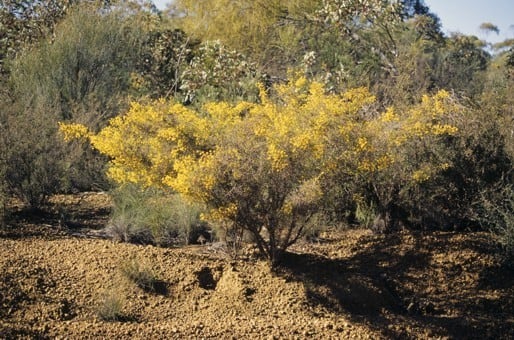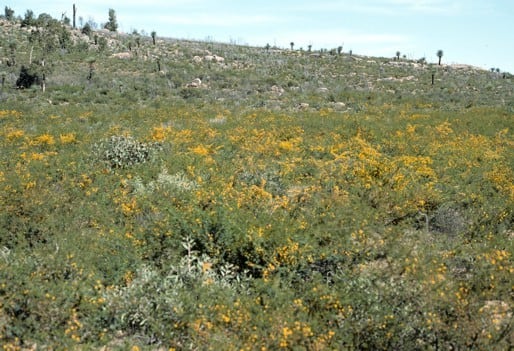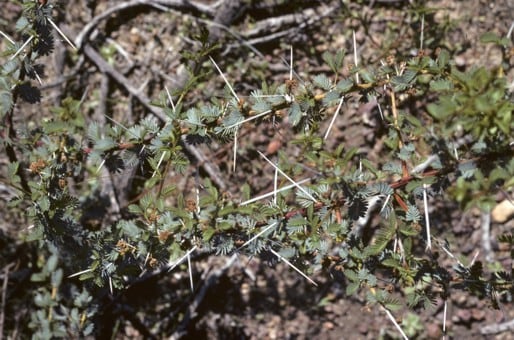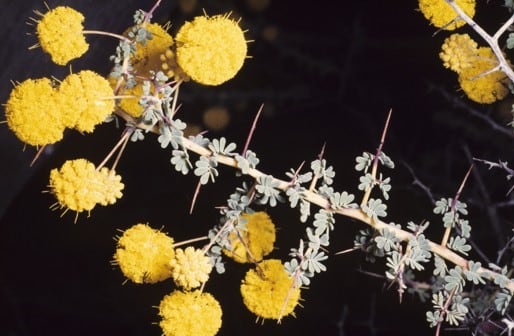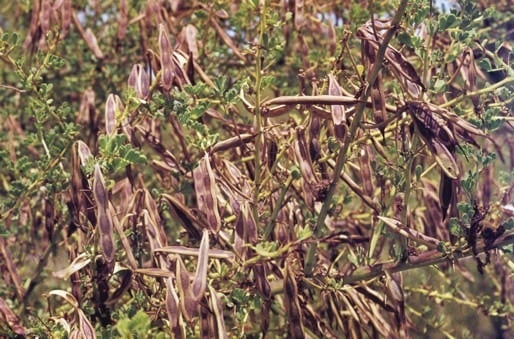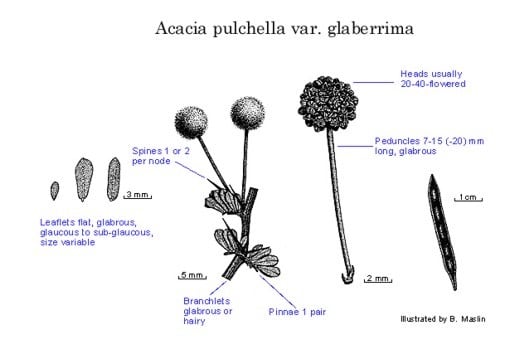Acacia pulchella var. glaberrima Meisn.
WATTLE
Acacias of Australia
Family
Fabaceae
Distribution
Occurs from near Jurien S to near Augusta and Ravensthorpe, and in the Port Gregory–Northampton district (c. 250 km N of Jurien), W.A.; naturalised and weedy in Deep Creek Conservation Park, S.A.
Description
Branchlets normally finely ribbed, commonly lightly pruinose, glabrous, sometimes hairy. Axillary spines 1 or 2 per node. Leaves variable; petiole > 0.5 mm long; pinnae 1–15 mm long; pinnules 3–11 pairs, obovate to oblanceolate or narrowly oblong, 1–6 mm long, glaucous to subglaucous, sometimes pale green (especially on new growth and when in fruit). Peduncles 7–15 (–20) mm long, glabrous; bracteoles ovate. Pods 4–5 (–7) mm wide.
Habitat
Grows mainly in sandy and lateritic soils in woodland, scrub and heath, and in loamy clay near swamps.
Specimens
W.A.: Swan R., J.Drummond 2: 156 (?BM, CGE, E, G-DC, K, LD, NSW, OXF, P, W); 4.8 km E of Donnybrook towards Collie, B.R.Maslin 612 (MEL, NSW, PERTH: hairy branchlet variant) and 613 (MEL, NSW, PERTH); c. 32 km W of Ravensthorpe, S.Paust 706 (PERTH: small leaf variant); Rosa Brook, R.D.Royce 4623 (PERTH: variant with slender peduncles and spines); 23 km from Port Gregory along Yerina Springs road, 15 Aug. 1985, N.Sammy (PERTH).
Notes
Variant 4 has pinnae 1–2 mm long; pinnules obovate or oblong-obovate, 1–3 mm long. Occurs at Wannamal and Wongan Hills S to near Williams to Ravensthorpe. Resembling A. amputata in being especially spinose and in having particularly small leaves.
Four variants with some morphological and geographic integrity are discriminated to accommodate the wide range of variation within this taxon. However, due to the complexity of the variation and the presence of intermediates, formal rank has not been attributed to them.
Sympatric with var. pulchella and var. goadbyi in places. Appears occasionally to hybridise with the typical variety, especially between Perth and Dunsborough.
The typical variant (variant 1) has glabrous branchlets. Axillary spines 5–20 mm long. Leaves variable; pinnae 3–4 mm long with 3–4 pairs of obovate to oblanceolate pinnules, but ranging to 4–10 mm long with 5–8 pairs of narrowly oblong to oblanceolate pinnules; pinnules mostly 3–5 mm long. Heads 20–40-flowered. This variant is widespread from near Jurien to Lake Muir; an outlier near Port Gregory has c. 50 flowers per head.
Variant 2 has pilose, villous or pubescent branchlets. Pinnae 6–15 mm long; pinnules 5–11 pairs, narrowly oblong to narrowly obovate. It is common on laterite near Dunsborough (indumentum dense; corresponds to the type of A. hispidissima), infrequent elsewhere (with indumentum usually sparser; seems to correspond to the type of A. grandis).
Variant 3 has slender spines, 2–4 mm long; pinnules 1–2 mm long. Peduncles very slender. Heads 15-flowered. It occurs at Rosa Glen, near Margaret River. Typical var. glaberrima occurs nearby.
FOA Reference
Data derived from Flora of Australia Volumes 11A (2001), 11B (2001) and 12 (1998), products of ABRS, ©Commonwealth of Australia
Author
B.R.Maslin
This identification key and fact sheets are available as a mobile application:
URL: https://apps.lucidcentral.org/wattle/
© Copyright 2018. All rights reserved.
